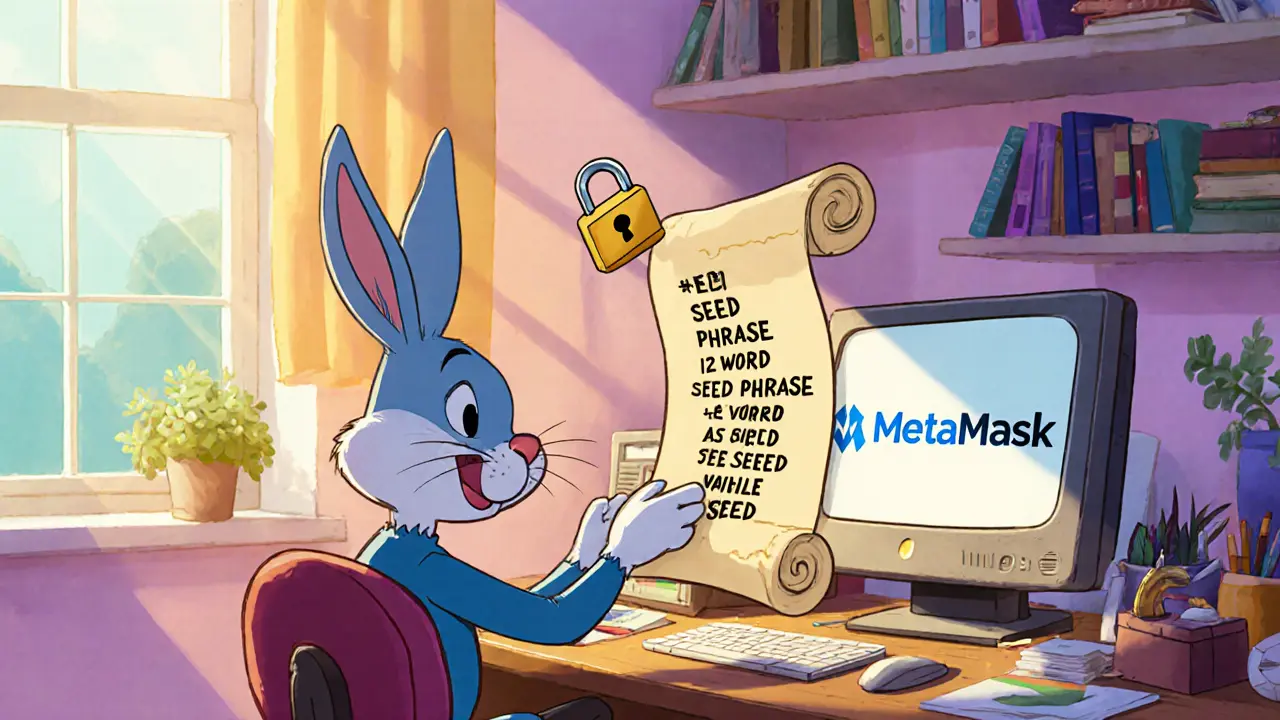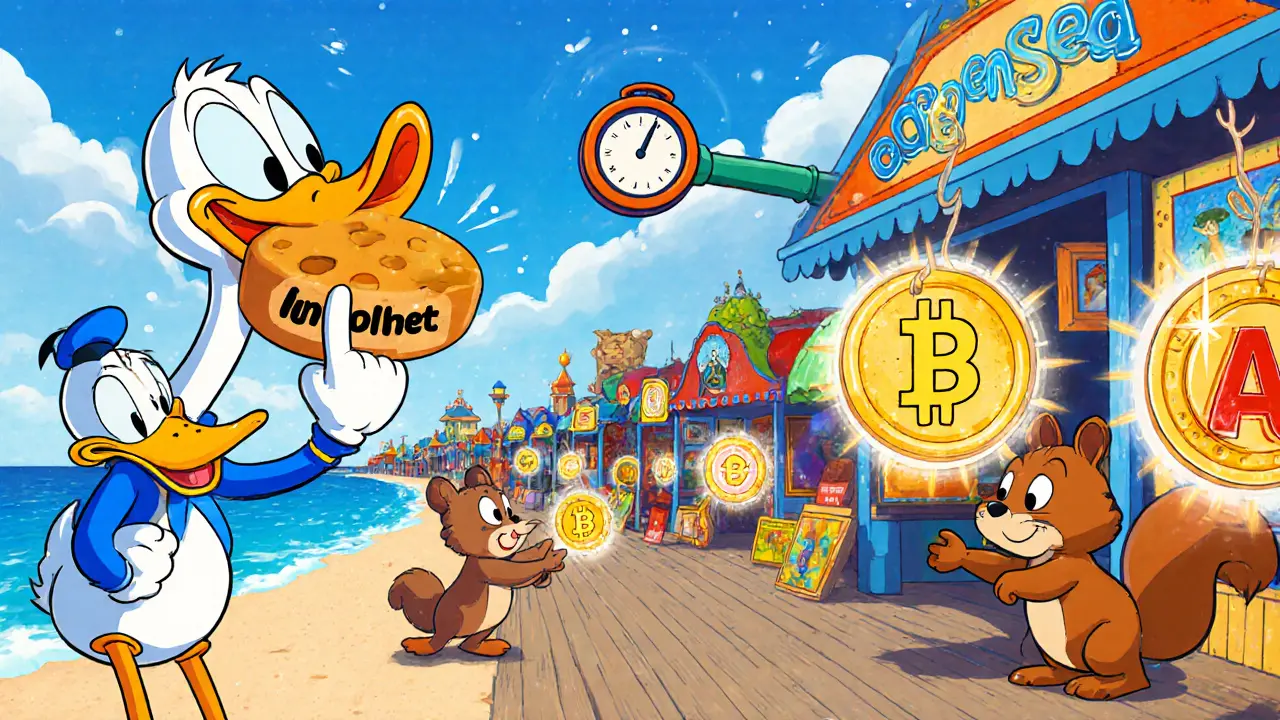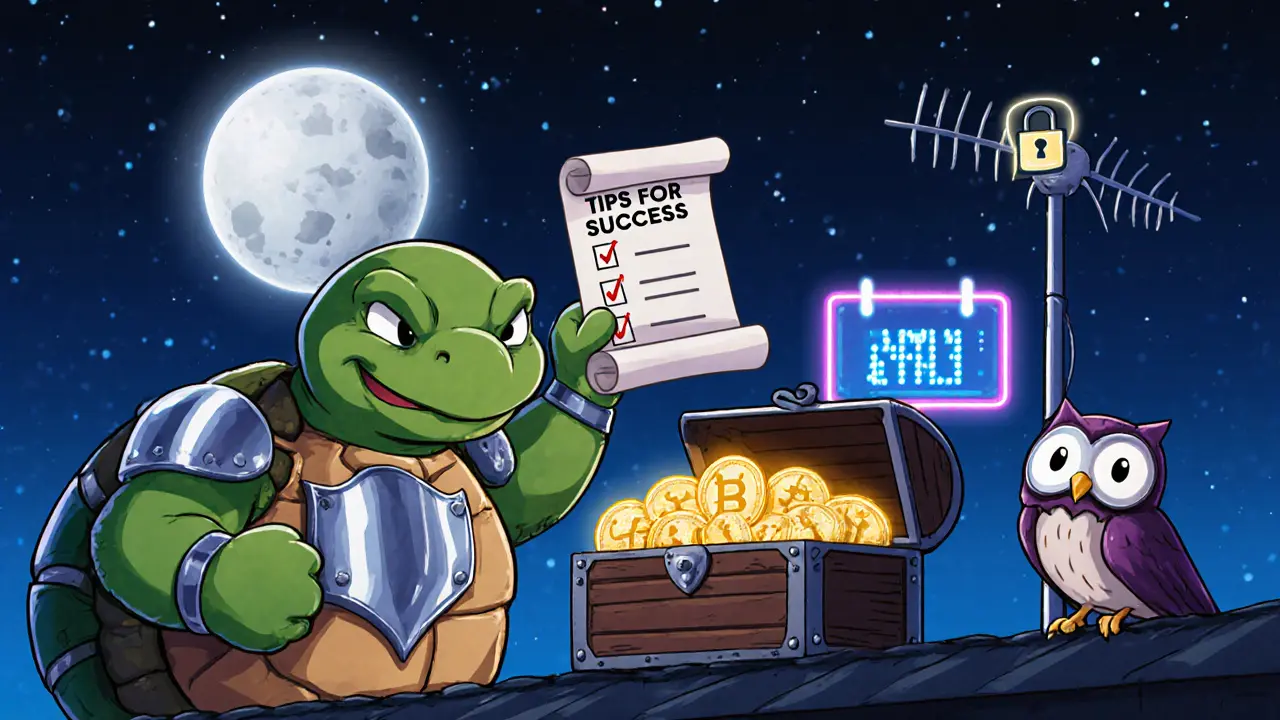How to Buy and Sell NFTs: Step-by-Step Guide for 2025
 Mar, 9 2025
Mar, 9 2025
Key Takeaways
- Set up a secure crypto wallet (MetaMask or hardware) before you touch any NFT.
- Fund the wallet with ETH or a low‑fee chain token like MATIC.
- OpenSea still holds the biggest market share, but Polygon and Solana offer cheaper gas.
- Use fixed‑price listings for confidence, auctions for hype, and always set a reserve if you need a safety net.
- Protect your private keys, verify contract addresses, and keep an eye on evolving regulations.
Non‑fungible tokens have turned digital art, music, and even real‑world items into tradeable assets. If you’ve been watching the hype since 2021, you’ll notice the landscape has steadied. By 2025 the core process-wallet, crypto, marketplace-remains the same, but fees have dropped, UI’s are friendlier, and new blockchains give you more options. This guide walks you through every move you need to make, from the moment you download a wallet to the point where you list a piece of art for sale.
NFT (Non-Fungible Token) is a unique digital asset recorded on a blockchain that proves ownership and authenticity. Each NFT lives under a smart contract, a piece of code that automatically enforces the transfer rules. The most popular chain for NFTs is Ethereum a public, permissionless blockchain that uses the ETH token for transactions, but alternatives like Polygon a layer‑2 scaling solution that offers much lower transaction costs and Solana a high‑throughput blockchain known for sub‑dollar fees have gained traction.
1. Set Up a Crypto Wallet
The wallet is your digital vault. It stores private keys, sign‑sends transactions, and connects to marketplaces. For beginners, MetaMask a browser‑based wallet that works with most NFT platforms is the easiest start. If you plan to hold high‑value pieces, consider a hardware device like Ledger or Trezor-these keep keys offline.
- Download the MetaMask extension for Chrome, Firefox, or Brave.
- Create a new wallet, write down the 12‑word seed phrase on paper, and store it safely.
- Set a strong password for the extension; it protects the local encryption of your keys.
Once the wallet is ready, you’ll need cryptocurrency to pay for purchases and the inevitable gas fee the cost paid to validators for processing a blockchain transaction.
2. Fund Your Wallet
You can buy ETH, MATIC, or SOL on regulated exchanges such as Coinbase, Binance, or Kraken. After buying, withdraw the crypto to your wallet address-MetaMask shows a “Copy Address” button for a quick paste.
- Check the network you’re withdrawing to. Sending ETH to a Polygon address will lose the funds.
- Consider moving a small test amount first (e.g., $10) to confirm the address works.
- When you’re comfortable, fund the wallet with the amount you plan to spend on NFTs plus a buffer for gas.

3. Choose the Right Marketplace
Marketplaces are the storefronts where creators list NFTs and collectors browse. OpenSea the biggest NFT marketplace, handling over 80% of secondary‑sale volume in 2025 remains the go‑to for most users. Other options include Foundation (curated art), SuperRare (high‑end pieces), and newer platforms on Polygon and Solana that tout near‑zero fees.
| Feature | Ethereum | Polygon | Solana |
|---|---|---|---|
| Primary Token | ETH | MATIC | SOL |
| Typical Gas (USD) | $10‑$100 (high congestion) | $0.01‑$0.10 | $0.001‑$0.01 |
| Marketplace Support | OpenSea, Rarible, Foundation | OpenSea (Polygon), Mintable | Solanart, Magic Eden |
| Security Track Record | Longest, most battle‑tested | Layer‑2, inherits Ethereum security | High throughput, newer audits |
| Community Size | Large, diverse | Growing, artist‑focused | Gaming‑heavy, fast‑adoption |
4. How to Buy NFTs
Buying is a three‑step dance: find, add to cart, confirm.
- Navigate to the marketplace (e.g., OpenSea) and connect your MetaMask wallet via the “Connect Wallet” button.
- Search or browse collections. Use filters like “price < $200” or “high floor” to narrow results.
- Click on a piece you like. Review the creator’s profile, royalty terms, and contract address (always verify the address matches the official page).
- If it’s a fixed‑price listing, hit “Buy Now”. For auctions, place a bid and wait for the timer to end.
- Your wallet will pop up asking you to confirm the transaction and show the estimated gas fee. Approve the transaction and wait a few seconds for the blockchain to confirm.
After the transaction succeeds, the NFT appears in your wallet’s “Collectibles” tab and on your OpenSea profile.
5. How to Sell NFTs
Whether you’re a creator or a collector, selling follows a similar flow, with extra decisions on pricing.
- Go to your profile, select the NFT you want to list, and click “Sell”.
- Choose a sale type:
- Fixed price: Set a single price and let buyers purchase instantly.
- Timed auction: Set a start time, end time, and optional reserve price.
- Reserve auction: Bids must meet the minimum you define before the item is sold.
- Enter your price in ETH, MATIC, or SOL, depending on the chain you’re using.
- Specify royalty percentage if you’re the creator (most platforms default to 5‑10%).
- Confirm the listing. You’ll pay a one‑time gas fee to write the sale order onto the blockchain.
- Promote your listing on Discord, Twitter, or relevant NFT communities. A strong community often decides the final sale price.
When a buyer completes the purchase, the platform automatically transfers the NFT to their wallet and sends you the proceeds less the platform’s service fee (OpenSea charges 2.5% on sales).

6. Managing Fees and Security
Fees can erode profit, especially on Ethereum during peak traffic. Here are practical ways to keep costs down:
- Use layer‑2 networks (Polygon, Arbitrum) for low‑cost minting and sales.
- Schedule transactions during off‑peak hours (late night UTC) to get cheaper gas.
- Batch multiple actions (e.g., approve several NFTs at once) to share one gas payment.
- Consider a hardware wallet for high‑value holdings; the added security outweighs the slightly higher transaction steps.
Security habits are non‑negotiable:
- Never share your seed phrase. Store it offline, preferably in a fire‑proof safe.
- Double‑check contract addresses before signing. Scammers often clone popular projects with slightly altered addresses.
- Enable phishing‑detection extensions or use the official app store for wallet downloads.
- Keep your browser and wallet extensions up to date.
7. Tips for Success in 2025
The NFT market isn’t a pure gamble; it rewards community, utility, and clear rights.
- Research the creator’s roadmap. Projects that plan future utility (gaming, exclusive events) tend to retain value.
- Check royalty clauses. Ensure the smart contract states who can use the artwork and whether you receive a share of secondary sales.
- Watch the regulatory landscape. The EU’s MiCA rules may affect how platforms verify users; be ready to supply KYC info if required.
- Don’t chase FOMO. Set a budget, ignore hype‑driven price spikes, and buy only what you truly like.
- Engage with the community. Discord channels and Twitter Spaces often give early hints about upcoming drops.
Frequently Asked Questions
Do I need ETH to buy NFTs on Polygon?
No. Polygon uses its native token MATIC for gas and purchases. Some marketplaces let you pay with ETH, but it will be wrapped into a Polygon‑compatible form.
Can I sell an NFT I bought on OpenSea on a different platform?
Yes, as long as the NFT’s contract is supported on the second platform. You’ll need to transfer it, which incurs a gas fee.
What is a “lazy mint” and should I use it?
Lazy minting creates the NFT metadata off‑chain and only writes the contract to the blockchain when it sells, saving the creator upfront gas. It’s great for artists testing the market, but buyers should verify that the final mint will occur as promised.
How do royalties work on secondary sales?
The smart contract stores a percentage (usually 5‑10%) that automatically sends the set amount to the creator each time the NFT changes hands. The royalty is enforced by the blockchain, not by the marketplace.
Is buying an NFT the same as owning the copyright?
No. An NFT proves you own a token linked to the file. Copyright stays with the creator unless the contract explicitly transfers those rights. Always read the licensing terms.
gayle Smith
March 9, 2025 AT 08:59Alright, strap in because the NFT arena isn’t just a marketplace, it’s an ecosystem of cryptographic provenance, smart‑contract arbitration, and community‑driven hype cycles. When you fire up MetaMask, you’re essentially installing a gateway to the decentralized ledger where every tokenized asset lives. Remember to double‑check the contract address; a single typo can catapult you into a phishing vortex faster than a gas‑price spike. Layer‑2 solutions like Polygon are the stealth mode for low‑fee collectors, while Ethereum remains the flagship for high‑value drops. Bottom line: treat each transaction as a micro‑investment in digital scarcity.
mark noopa
March 18, 2025 AT 15:12Navigating the NFT labyrinth is akin to chasing the meaning of existence in a digital wasteland.
Every token you mint feels like a tiny echo of your own identity, a phantom imprint on a public ledger that no one can truly erase.
When you pay gas, you’re not just spending ETH, you’re funding the consensus mechanism that keeps the network alive, like feeding a digital beast that never sleeps.
The paradox is that while you’re chasing scarcity, the blockchain itself is infinitesimally abundant, replicating data across nodes worldwide.
💡 Philosophically, this suggests that value is a social contract, not an inherent property of code, which is why communities matter more than the art itself.
🚀 On the practical side, always use a hardware wallet for high‑value drops; software wallets are convenient but they’re the first target for ransomware.
Don’t forget to bridge assets to Layer‑2 before you list; the gas fees on Ethereum can devour your profit faster than a flash‑crash on a meme coin.
And yes, the hype cycles do follow a sine‑wave pattern, rising with celebrity endorsements and crashing after the next airdrop mania.
🤔 If you’re feeling the FOMO, remember to set a hard cap on your spend – a budget is the only true shield against market volatility.
Any deviation from this disciplined approach almost guarantees a regretful ledger entry, an indelible scar on your crypto credit history.
Beware of "lazy mint" scams: they promise zero upfront cost, but they often hide malicious code that can seize control of your wallet later.
The community whispers about certain contracts that are back‑doored to siphon royalties; always read the contract source on Etherscan.
Regulatory shadows are lengthening too – the EU’s MiCA framework could require KYC at the point of mint, turning anonymity into a relic.
In short, treat each NFT transaction as both an artistic statement and a financial instrument, never letting one eclipse the other.
Stay curious, stay skeptical, and most importantly, stay hydrated while you chase those digital dreams. 😊
Nina Hall
March 27, 2025 AT 21:25Love the step‑by‑step vibe – it makes the whole NFT process feel like a friendly tutorial rather than a steep cliff. Adding a splash of color to the guide with those bright screenshots really helps newbies picture the flow. The tip about batch‑approving transactions on Polygon saved me a few bucks the last time I minted a series. Keep the upbeat tone, it’s contagious and makes the tech feel accessible!
Lena Vega
April 6, 2025 AT 03:39Great, concise checklist for beginners.
Sanjay Lago
April 15, 2025 AT 09:52Hey folks, just wanted to add that joining Discord servers of the collections you like can give you early intel on upcoming drops – super helpful! Also, if you’re on a tight budget, try swapping a tiny bit of ETH for MATIC on a DEX; the fee difference is crazy. Don’t forget to enable two‑factor auth on your exchange accounts, it’s the simplest way to block phishing attempts. Lastly, keep an eye on the gas tracker during off‑peak hours – you’ll thank yourself later.
arnab nath
April 24, 2025 AT 16:05They don’t tell you that most NFT marketplaces are secretly owned by the same conglomerates pulling the strings behind the scenes. Watch out for the hidden data‑mining scripts they embed in the UI – it’s a backdoor for surveillance. The regulators are already on to them, but the crypto world stays blissfully ignorant.
Nathan Van Myall
May 3, 2025 AT 22:19When you connect your wallet, always verify the URL ends with the official domain; phishing sites mimic the UI perfectly. Also, there’s a handy Chrome extension that flags known malicious contract addresses, giving you an extra safety net. Remember, the blockchain will never roll back a transaction, so double‑check before you click ‘Confirm’.
Manas Patil
May 13, 2025 AT 04:32From a cultural standpoint, NFTs are becoming the new canvas for artists in emerging markets, especially across South Asia where mobile‑first audiences thrive. The low‑fee environment on Polygon has unlocked a wave of indie creators who can finally afford to mint without burning cash on gas. It’s also reshaping how fans engage, turning them into co‑owners rather than passive consumers. Keep an eye on these regional trends; they’re often the early indicators of the next big wave.
Annie McCullough
May 22, 2025 AT 10:45Honestly i think all this hype is just a fad its overrated and we dont need another digital collectible bubble it’s just noise lol
Lady Celeste
May 31, 2025 AT 16:59This guide is too fluffy, it skips the real risks. Most newbies lose money.
Ethan Chambers
June 9, 2025 AT 23:12One could argue that the very notion of ‘ownership’ in NFTs is a post‑modern construction, a simulacrum of property in a hyper‑real market. Yet the fervor persists, driven by a desire for digital distinction. It’s almost theatrical, a performance art of speculation. In any case, the mechanics remain unchanged.
Philip Smart
June 19, 2025 AT 05:25Meh, another guide about NFTs. Nothing new here.
debby martha
June 28, 2025 AT 11:39Honestly the article hits the basics but could've dug deeper into cross‑chain bridges. Also, the section on royalties felt a bit thin.
Orlando Lucas
July 7, 2025 AT 17:52There’s an elegant symmetry in how NFTs merge code and culture, creating a feedback loop that drives both technical innovation and artistic expression. While the guide does a solid job outlining the procedural steps-wallet setup, funding, marketplace navigation-it could benefit from a philosophical footnote about why we assign value to digital scarcity at all. That said, the practical tips about gas optimization and hardware wallets are spot on, especially for newcomers wary of losing funds. Remember, every transaction you sign is a permanent imprint on a public ledger, so treat each click with the same gravity you’d give a real‑world contract. If you’re looking to future‑proof your collection, keep an eye on emerging standards like ERC‑721A, which promise lower minting costs. Ultimately, the ecosystem thrives on community collaboration, so engage, share, and iterate.
Mureil Stueber
July 17, 2025 AT 00:05Quick tip: always whitelist your wallet address in the marketplace’s preferred token list to avoid the “unsupported network” error. It’s a simple checkbox but it saves you a frustrating reload. Also, consider setting a custom gas price on MetaMask; the default can overpay during peak times. Lastly, join the official Discord of the collection you’re interested in – they often post exclusive minting windows that aren’t advertised elsewhere.